
|   |

|   |
Raindrops Festival of Classical Dance - Dr. Sunil Kothari e-mail: sunilkothari1933@gmail.com July 27, 2013 The 23rd edition of the Raindrops Festival of classical dance on July 20 organized by the celebrated Kathak exponent Uma Dogra under the aegis of Sam Ved Society for Performing Arts in association with SAB Miller India held at Mini Ravindra Natya Mandir aka P.L Deshpande Theatre, next to Siddhivinayak Temple, Prabhadevi, Mumbai was a runaway success in spite of the torrential July rains. No wonder Uma has given this festival the name Raindrops, justifying the heralding of dance and music festivals in Mumbai with the onset of monsoon. The rains did not stop Mumbaikars and dance lovers from making their way to the mini theatre which was packed. It was indeed very heartening to see the excitement and the crowds for the dance festival. Uma's daughter Suhani, a writer in her own right and currently on the staff of India Today, politely requested the disciples of Uma and Sam Ved Society to give seats to the senior citizens and invitees. I left Mumbai in June 1980 to join as a Professor and Head of the Dance Dept of Rabindra Bharati University at Kolkata. I used to say, "You can take Sunil Kothari anywhere, but you cannot take Bombay out of him." Whenever I visit Mumbai, I feel very emotional and like the Greek poet Cavafy says, I carry the city with me. 23 years is a remarkably long period and Raindrop Festival is going from strength to strength. I do visit Mumbai, but for the last five years it has been occasionally and I miss various cultural events and dance festivals. I had missed Raindrops Festival all these years. Therefore, since I had come to Mumbai for a family get-together, I decided to stay back and attend the festival. And I must confess I was rather surprised. I was given to understand that classical Indian dance scene is bleak in Mumbai. There is no audience anymore, what with Jhalak Dikhla Ja and other television shows weaning audiences away from classical dances to Bollywood dances, jerk and grind movements, comments of choreographer Remo, the beauteous Madhuri Dixit, the sauve Karan Johar and guests and audiences sit glued to TV shows! Therefore, when young members in the audience, including middle aged and senior citizens were seen engrossed in watching young dancers and lustily cheering when they performed so well, winning rounds of applause, I realized that one need not despair. Classical dances are safe and sound and will survive and are thriving. Yes, in Mumbai, in spite of Bollywood dancing being seen by millions all over the country and also abroad by Indian Diaspora and by dance viewers. 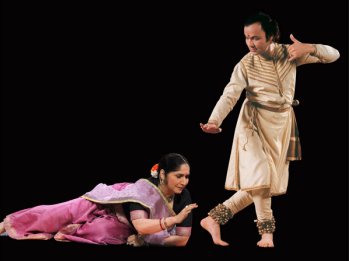 Uma Dogra, Pt Durga Lal
Photo: Avinash Pasricha Uma had wisely invited dancers from young generation from two different cities - Kathak exponents Murali Mohan and Nandini Mehta from Bangalore, Odissi exponent Ayona Bhaduri, from Kolkata, two Indian Diaspora dancers, Rinku Bhattacharya Das (Manipuri) from North Carolina and Kuchipudi dancer Srilekha Jayanthi from Washington DC. Both have been dividing their time between USA and India. The two dancers from Mumbai were Kathak exponent Sakshi Kumar, a disciple of Birju Maharaj's son Jaikishan Maharaj and Bharatanatyam exponent Sonali Surve Gawade trained at Dr. Kanak Rele's institution Nalanda Mahavidyalaya under the guidance of that gifted brilliant male Bharatanatyam dancer Vaibhav Arekar. Ayona Bhaduri with her two musicians, vocalist Rajeswar Swain and percussionist also with family name Swain, arrived very late from Kolkata as the trains were delayed because of the heavy rains, but she reached in time and performed with such involvement and passion with superb support from the two musicians that she electrified the venue and was like a cherry on the cake concluding the festival. Bravo Ayona! The audience lingered even when the program concluded by 9.30pm. I am proud of Mumbaikars who gave such wonderful support to the dancers by staying back and encouraging them. Also, full marks to the indefatigable Uma Dogra and her team. Sakshi began with Shiva vandana and with live music led by ace tabla maestro Kali, vocalist and sitar player Anjali. She displayed her taiyyari in Kathak in a delectable manner. Her 'ang' (bodily) movements were full of nazakat (grace) and khubsoorati (beauty), the hallmark of Lucknow gharana. Her training under Jaikishan Maharaj is praiseworthy. The various infra- numbers of pure dance including nine matra Basant, choicest ginati, parans, ladi, tihais were enjoyable. Sakshi proved that she has on account of her sound training mastered the technique well and is a dancer of merit. Bindadin Maharaj's thumri Mohe Chhedo na Nanda ke, a gopi requesting Krishna not to tease her and let her go back home had interesting bhavas. The jugabandi between tabla wizard Kali and Sakshi won rounds of applause, which they deserved. Sakshi deserves to be seen more not only in Mumbai but also in other cities and of course one would love to see her in Delhi during the Kathak Mahotsav. 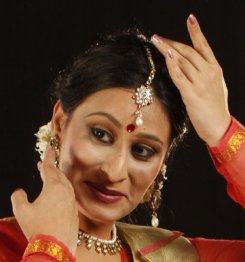 Sakshi Kumar 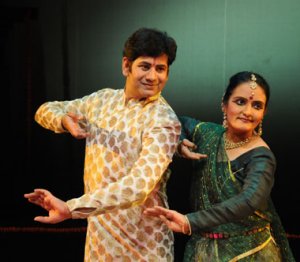 Murali Mohan and Nandini Mehta Murali Mohan and Nandini Mehta from Bangalore have earned fame and name for their aesthetic Kathak presentation as a duo. Both are mature and dignified artistes. Murali Mohan's gentle commentary, replete with humour and also humility is a winning point as audiences relish it. Besides teen taal, they chose to present two abhinaya numbers which indeed were most welcome. I have enjoyed them having seen them in Delhi and elsewhere. But for Mumbaikars it was perhaps surprising to witness how the wonderful Kannada padam Krishna nee begane baro popularized by the legendary Balasaraswati was interpreted by the couple. Instead of impersonating Krishna, Nandini and Murali presented it through the eyes of parents Nanda and Yashoda, each one wanting to play with child Krishna and they depicted 'apatya vatsalya', love of parents in an endearing manner. They also incorporated the story of Vasudev bringing Krishna from jail to Gokul and replacing him with another child. The playfulness of both parents playing with Krishna was imaginative and spoke well of their approach. Similarly, in the popular composition by Pandit Jasraj in Maru Bihag, Lat ulzi sulza ja re balam, the nayika with her palms painted with mehndi, requesting the nayak to arrange her disarrayed hair, putting bindi on forehead, tying ankle bells on her feet and so on performed by Nandini was enacted with various shades of emotions in a telling manner. Rinku Bhattacharya Das trained by Guru Bipin Singh and Darshana Jhaveri for the past twenty years displayed the Manipuri stamp of her mentors faithfully, dancing Bajigar vesh, Krishna as Bajigar in disguise to meet Radha, performing acrobatics, using various movements from pung cholom, spirals, dancing on knees, taking aerial somersaults received instant applause from the audience. Delicate in her build and frame, Rinku has internalized Guru Bipin Singh's style thoroughly, including the distinct neck movements. The nayika bhedas were suggestive, brief and according to the Vaishnava sastra. In Mandila Nartan, the composition Ratan hindol par baithal Radha Madhav and execution of cymbals were perfect with commendable synchronization. Darshana Jhaveri's choreography revived for me pleasant memories of performance of the Jhaveri Sisters and Guruji's evergreen compositions. It is commendable that Rinku carries on this legacy with such fidelity. The supervision of both Latasana, another senior disciple of Guru Bipin Singh, and Darshana Jhaveri, has helped Rinku to project Guru Bipin Singh's style successfully. 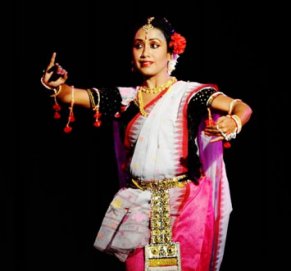 Rinku Bhattacharya Das 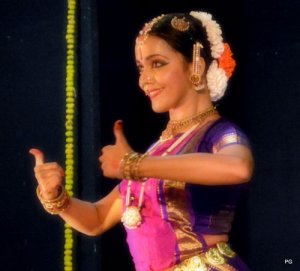 Sonali Surve Gawade Sonali Surve Gawade trained at Nalanda Nritya Kala Mahavidyalaya and under Vaibhav Arekar, displayed her youthful exuberance, stamina and command over the technique. Opening with Mallari, the sequence of procession and the musicians playing drums, instruments, the ritualistic element et al were eye catching. Vaibhav Arekar's choreography of Swati Tirunal's composition in Hamsanandi praising Lord Shiva's dance had the vigour of tandava and Sonali performed it with zest. Shiva dancing in Chitrasabha sequence was arresting. Sonali registered appropriate bhavas, showing the benign and demonic aspects of the Goddess in the depiction of Mahalakshmi, Mahakali Durga, Mahishasuramardini in a specially choreographed composition by Vaibhav. The Marathi composition popularized by Manik Varma about Radha and Krishna sulking and the poet describing the entire Gokul reflecting the mood of the divine lovers' feelings and finally reconciling had enjoyable moments. A fine dancer, she impressed the audience with her several years of sound practice. Srilekha Jayanthi, a disciple of Anuradha Nehru (senior disciple of late Vempati Chinna Satyam) with the very entry and her quicksilver movements, established the hallmark of Vempati bani. The sophistication, the graceful postures, the erect body posture, sausthava, drew one's attention to her training of many years. In Natesha Kavutvam, Srilekha transformed the attributes of the Lord Naadyogapriya, Shashiravi bhushana, Damarukahastaka with hastas and angikabhinaya, sculpting the iconic form beautifully as choreographed by Vempati. The composition Govardhana Giridhara followed by Tarangam saw her in fine fettle, weaving in stories of Krishna's pranks and performing on rim of brass plate competently, which the audience applauded. However, because of recorded music the jugalbandi element did not create excitement as live music does. A seasoned dancer, she did her guru and Vempati bani proud. The covering of the stage with lilting walk was eye catching and full of verve. 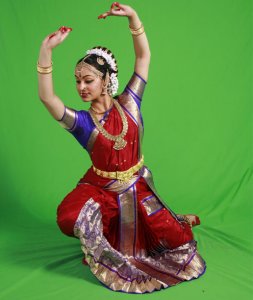 Srilekha Jayanthi 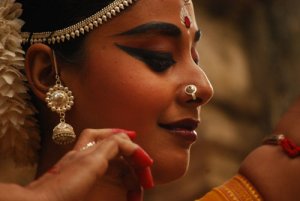 Ayona Bhaduri In the finale, Ayona Bhaduri, who studied Odissi under Surupa Sen and Bijayini for more than ten years took to the stage with live music by singer and percussionist, and transformed the atmosphere with her brilliant dancing. She has a sensuous frame, typical Nrityagram stamp, be it costumes, sculpturesque poses, strong footwork in keeping with mardala playing and with beatific pleasant smiling expressions revealing her inner joy of dancing, be it Bhumi Pranam, a Kiravani Pallavi choreographed by Kelubabu and set to music by Bhubaneswar Misra, or a song To laagi gopa danda complaining to Krishna that on account of his pranks she is unable to go to Jamuna to fetch water. In different numbers, Ayona succeeded in conveying to the audience the essence of nritta as in Kiravani Pallavi, and charming expressions in nritya, expressional dance, proving in an effortless manner her command over the idiom. Her resolutions were flawless, movements arresting and joy of dancing internalized and expressed through her entire frame. The two musicians lent her such wonderful support showing the perfect unity between her dance and their musical accompaniment. Ayona is currently working with Sharmila Biswas at Kolkata. Uma Dogra and her team of workers including her daughter Suhani Singh deserve praise for mounting such an enjoyable festival of young talented dancers in Mumbai. That the audience gave the festival such wonderful support speaks volumes for Uma Dogra's dedication, perseverance, faith in doing what she does, encouraging young dancers. Wishing Uma Dogra great success, one looks forward to the silver jubilee of the festival.  Dr. Sunil Kothari is a dance historian, scholar, author and a renowned dance critic. He is Vice President of World Dance Alliance Asia Pacific India chapter, based in New Delhi. He is honored by the President of India with Padma Shri, Sangeet Natak Akademi award and Senior Critic Award from Dance Critics Association, NYC. He is a regular contributor to www.narthaki.com, the roving critic for monthly magazine Sruti and is a contributing editor of Nartanam for the past 12 years. Response * It was the first time eminent dance critic Dr. Sunil Kothari attend the Raindrops Festival and shared his thoughts. Thanks a lot. Uma Dogra (July 28, 2013) Post your comments Pl provide your name and email id along with your comment. All appropriate comments posted with name and email id in the blog will also be featured in the site. |